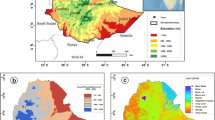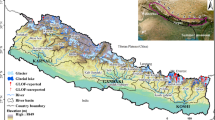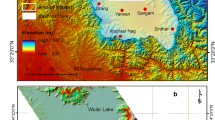Abstract
Because of the large number and remoteness, satellite data, including microwave data and optical imagery, have commonly been used in alpine glaciers surveys. Using remote sensing and Geographical Information System (GIS) techniques, the paper presents the results of a multitemporal satellite glacier extent mapping and glacier changes by glacier sizes in the Mt. Qomolangma region at the northern slopes of the middle Himalayas over the Tibetan Plateau. Glaciers in this region have both retreated and advanced in the past 35 years, with retreat dominating. The glacier retreat area was 3.23 km2 (or 0.75 km2 yr−1) during 1974 and 1976, 8.68 km2 (or 0.36 km2 yr−1) during 1976 and 1992, 1.44 km2 (or 0.12 km2 yr−1) during 1992–2000. 1.14 km2 (or 0.22 km2 yr−1) during 2000–2003, and 0.52 km2 (or 0.07 km2 yr−1) during 2003–2008, respectively. While supra-glacier lakes on the debris-terminus of the Rongbuk Glacier were enlarged dramatically at the same time, from 0.05 km2 in 1974 increased to 0.71 km2 in 2008, which was more than 13 times larger in the last 35 years. In addition, glacier changes also showed spatial differences, for example, glacier retreat rate was the fastest at glacier termini between 5400 and 5700 m a.s.l than at other elevations. The result also shows that glaciers in the middle Himalayas retreat almost at a same pace with those in the western Himalayas.
Similar content being viewed by others
References
Ashish, A., Joshi, V., Sharma, A. and Anthwal, S. 2006.Retreat of Himalayan glaciers — indicator of climate change. Nature and Science 4(4): 53–60.
Bishop M.P., Olsenholler J.A., Shroder J.F., et al. 2004. Global land ice measurements from space (GLIMS): Remote sensing and GIS investigations of the Earth’s Cryosphere. Geocarto International 19: 57–84.
Bindschadler, R., Julian Dowdeswell, Dorothy Hall et al. 2001. Glaciological applications with Landsat-7 imagery: Early assessments. Remote sensing of environment 78:163–179
Bolch, T., Buchroithner, M.F., Kunert, A., Kamp, U. 2007. Automated delineation of debris-covered glaciers based on ASTER data. Geoinformation in Europe (Proc. of 27th EARSel Symposium, 04–07 June 2007), Bozen, Italy, 403–410.
Bolch, T., Buchroithner, M.F., et al. 2008. Planimetric and volumetric glacier changes in the Khumbu Himal, Nepal, since 1962 using Corona, Landsat TM and ASTER data. Journal of Glaciology 54(187): 592–600.
Fujita K., Suzuki R., Nuimura T. and Sakai A. 2008. Performance of ASTER and SRTM DEMs, and their potential for assessing glacial lakes in the Lunana region, Bhutan Himalaya. Journal of Glaciology 54: 220–228.
Hall, D. K., Bayr, K. J., Schöner, W., et al. 2003. Consideration of the errors inherent in mapping historical glacier positions in Austria from the ground and space (1893–2001). Remote Sensing of Environment 86: 566–577.
IPCC. Climate Change 2007: The Physical Science Basis. Summary for Policymakers. Paris, 2007; 21.
Kääb, A. 2005. Combination of SRTM3 and repeat ASTER data for deriving alpine glacier flow velocities in the Bhutan Himalaya. Remote Sensing of Environment 94:463–474.
Kargel J.S., Abrams M.J., Bishop M.P., et al. 2005. Multispectral imaging contributions to global land ice measurements from space. Remote Sensing of Environment 99: 187–219.
LI, Z., SUN, W., and ZENG, Q. 1998. Measurements of glacier variation in the Tibetan Plateau using Landsat data. Remote Sensing of Environment 63: 258–264.
Mayewski, P.A., and Jeschke, P.A. 1979. Himalayan and Trans-Himalayan Glacier Fluctuations since Ad 1812. Arctic, Antarctic, and Alpine Research 11(3): 267–287.
Meier, M. F. 1973. Evaluation of ERTS imagery for mapping and detection of changes in snow cover on land and on glaciers. In: Symposium on significant results obtained from the earth resources technology satellite-1, NASA SP-327 Washington, DC: NASA. Pp. 863–875.
Racoviteanu, A. E., M. W. Williams, et al. 2008. Optical remote sensing of glacier characteristics: A review with focus on the Himalaya. Sensors 8(5): 3355–3383.
Raup B., Racoviteanu A., Khalsa S.J.S., et al. 2007. The GLIMS geospatial glacier database: A new tool for studying glacier change. Global and Planetary Change 56: 101–110.
Schneider, C., Schnirch, M., Acuña C., et al. 2007. Glacier inventory of the Gran Campo Nevado Ice Cap in the Southern Andes and glacier changes observed during recent decades. Global and Planetary Change 59: 87–100.
SHEN, Y. An overview of glaciers, retreating glaciers and their impact in the Tibetan Plateau. Cold and Arid Regions Environmental and Engineering Research Institute (CAREERI), Chinese Academy of Sciences (CAS), Lanzhou, China, 2004; 42.
Silverio, W., and Jaquet, J.-M. 2005. Glacial cover mapping (1987-1996) of the Cordillera Blanca (Peru) using satellite imagery. Remote Sensing of Environment 95: 342–350.
Williams, R. S. Jr., Hall, D. K., Sigurdsson, O., et al. 1997. Comparison of satellite-derived with ground-based measurements of the fluctuations of the margins of Vatnajökull, Iceland, 1973–1992. Annals of Glaciology 24: 72–80.
Williams, R. S. Jr., and J.G. Ferrigno. 2005. Satellite Image Atlas of Glaciers of the World: U.S. Geological Survey Fact Sheet fs-2005-3056. [http://pubs.usgs.gov/fs/2005/3056/fs2005-3056.pdf] or [http://www.glaciers.er.usgs.gov/]
XIE, Z. C., and SU, Z. 1975. Glacier development, quantity and diatribution on the northern slope of Mt. Everest. Report on the scientific expedition to the Mt. Everest in 1966–1968, modern glacier and landforms. Beijing,China: Science Press. Pp. 92–105. (In Chinese)
YANG, X.C., ZHANG, Y.L., ZHANG, W., et al. 2006. Climate change in Mt. Qomolangma Region in China during the last 34 years. Acta Geographica Sinica 61(7): 687–696.
YAO, T.D., WANG, Y.Q., LIU, S.Y., et al. 2004. Recent glacial retreat in High Asia in China and its impact on water resource in Northwest China. Science in China (D) 47(12): 1065–1075.
YE, Q.H., KANG, S.C., CHEN, F., et al. 2006a. Monitoring glacier variations on Geladandong mountain, central Tibetan Plateau, from 1969 to 2002 using remote-sensing and GIS technologies. Journal of Glaciology. 52(179): 537–545.
YE, Q.H., YAO, T.D., KANG, S.C., et al. 2006b. Glacier variations in the Mt. Naimona’ Nyi Region, Western Himalayas, in the last three decades. Annuals of Glaciology, 43: 385–389.
YE, Q.H., CHEN, F., STEIN, A., and ZHONG, Z. 2009. Use of a multi-temporal grid method to analyze changes in glacier coverage in the Tibetan Plateau. Progress in Natural Science, 19(7): 861–872.
Author information
Authors and Affiliations
Corresponding author
Rights and permissions
About this article
Cite this article
Ye, Q., Zhong, Z., Kang, S. et al. Monitoring glacier and supra-glacier lakes from space in Mt. Qomolangma region of the Himalayas on the Tibetan Plateau in China. J. Mt. Sci. 6, 211–220 (2009). https://doi.org/10.1007/s11629-009-1016-4
Received:
Accepted:
Published:
Issue Date:
DOI: https://doi.org/10.1007/s11629-009-1016-4




